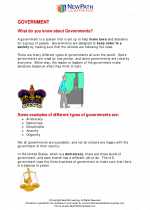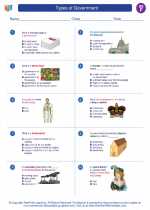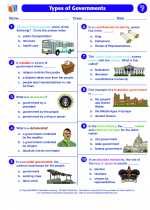Types of Government
Some examples of different types of governments are: Aristocracy, Democracy, Dictatorship, Anarchy, Oligarchy. Read More...
◂Social Studies Worksheets and Study Guides Sixth Grade. Types of Government
Study Guide Types of Government
Types of Government  Worksheet/Answer key
Worksheet/Answer key Types of Government
Types of Government  Worksheet/Answer key
Worksheet/Answer key Types of Government
Types of Government  Worksheet/Answer key
Worksheet/Answer key Types of Government
Types of Government  Worksheet/Answer key
Worksheet/Answer key Types of Government
Types of Government 

 Worksheet/Answer key
Worksheet/Answer key
 Worksheet/Answer key
Worksheet/Answer key
 Worksheet/Answer key
Worksheet/Answer key
 Worksheet/Answer key
Worksheet/Answer key

The resources above cover the following skills:
National Curriculum Standards for Social Studies (NCSS)
TIME, CONTINUITY, AND CHANGE
SOCIAL STUDIES PROGRAMS SHOULD INCLUDE EXPERIENCES THAT PROVIDE FOR THE STUDY OF THE PAST AND ITS LEGACY.
KNOWLEDGE - Learners will understand:
The origins and influences of social, cultural, political, and economic systems.
The history of democratic ideals and principles, and how they are represented in documents, artifacts and symbols.
POWER, AUTHORITY, AND GOVERNANCE
SOCIAL STUDIES PROGRAMS SHOULD INCLUDE EXPERIENCES THAT PROVIDE FOR THE STUDY OF HOW PEOPLE CREATE, INTERACT WITH, AND CHANGE STRUCTURES OF POWER, AUTHORITY, AND GOVERNANCE.
KNOWLEDGE - Learners will understand:
The ideologies and structures of political systems that differ from those of the United States.
The ways in which governments meet the needs and wants of citizens, manage conflict, and establish order and security.
PROCESSES - Learners will be able to:
Ask and find answers to questions about power, authority and governance in the region, nation, and world.
CIVIC IDEALS AND PRACTICES
SOCIAL STUDIES PROGRAMS SHOULD INCLUDE EXPERIENCES THAT PROVIDE FOR THE STUDY OF THE IDEALS, PRINCIPLES, AND PRACTICES OF CITIZENSHIP IN A DEMOCRATIC REPUBLIC.
KNOWLEDGE - Learners will understand:
Key documents and excerpts from key sources that define and support democratic ideals and practices (e.g., the U.S. Declaration of Independence, the U.S. Constitution, the Gettysburg Address, the Letter from Birmingham Jail; and international documents such as the Declaration of the Rights of Man, and the Universal Declaration of the Rights of Children).
National Standards for Civics and Government (NSCG)
What are civic life, politics, and government? What is civic life? What is politics? What is government? Why are government and politics necessary? What purposes should government serve?
Defining civic life, politics, and government. Students should be able to explain the meaning of the terms civic life, politics, and government. To achieve this standard, students should be able to
Identify institutions with authority to direct or control the behavior of members of a society, e.g., a school board, city council, state legislature, courts, Congress
What are civic life, politics, and government? What are the essential characteristics of limited and unlimited government?
Limited and unlimited governments. Students should be able to describe the essential characteristics of limited and unlimited governments. To achieve this standard, students should be able to
Describe the essential characteristics of limited and unlimited governments
Limited governments have established and respected restraints on their power, e.g., constitutional governments--governments characterized by legal limits on political power
Unlimited governments are those in which there are no effective means of restraining their power, e.g. authoritarian systems--governments in which political power is concentrated in one person or a small group, and individuals and groups are subordinated to that power; totalitarian systems--modern forms of extreme authoritarianism in which the government attempts to control every aspect of the lives of individuals and prohibits independent associations
Identify historical and contemporary examples of limited and unlimited governments and justify their classification, e.g.,
Unlimited governments--Nazi Germany, Imperial Japan, Spain under Franco, Argentina under Peron, Iraq under Hussein, Iran
What are civic life, politics, and government? What are alternative ways of organizing constitutional governments?
Shared powers and parliamentary systems. Students should be able to describe the major characteristics of systems of shared powers and of parliamentary systems. To achieve this standard, students should be able to
Describe the major characteristics of systems of shared powers, e.g., in the United States
Powers are separated among branches, each branch has primary responsibility for certain functions, e.g., legislative, executive, and judicial
Confederal, federal, and unitary systems. Students should be able to explain the advantages and disadvantages of confederal, federal, and unitary systems of government. To achieve this standard, students should be able to
Explain the major advantages and disadvantages of confederal, federal, and unitary systems
How does the government established by the constitution embody the purposes, values, and principles of American democracy? How are power and responsibility distributed, shared, and limited in the government established by the United States Constitution?
Distributing, sharing, and limiting powers of the national government. Students should be able to explain how the powers of the national government are distributed, shared, and limited. To achieve this standard, students should be able to
Explain how legislative, executive, and judicial powers are distributed and shared among the three branches of the national government
Legislative power--although primary legislative power lies with Congress, it is shared with the other branches, e.g., the executive branch can submit bills for consideration and can establish regulations, the Supreme Court can interpret laws and can declare them unconstitutional
Executive power--although primary executive power is with the executive branch, it is shared by the other branches, e.g., congressional committees have authority to review actions of the executive branch, the Senate must approve appointments and ratify treaties, the Supreme Court can review actions of the executive branch and declare them unconstitutional
Judicial power--although primary judicial power is with the federal judiciary, it is shared with other branches, e.g., the president appoints federal judges, the Senate can approve or refuse to confirm federal court appointees, the executive branch can hold administrative hearings on compliance with regulations and laws, Congress can ''overturn'' a Supreme Court interpretation of a law by amending it
Explain how each branch of government can check the powers of the other branches
Legislative branch has the power to establish committees to oversee activities of the executive branch; impeach the president, other members of the executive branch, and federal judges; pass laws over the president's veto by two-thirds majority vote of both Houses; disapprove appointments made by the president; propose amendments to the United States Constitution
Executive branch has the power to veto laws passed by Congress; nominate members of the federal judiciary
Judicial branch has the power to overrule decisions made by lower courts; declare laws made by Congress to be unconstitutional; declare actions of the executive branch to be unconstitutional
Sharing of powers between the national and state governments. Students should be able to explain how and why powers are distributed and shared between national and state governments in the federal system. To achieve this standard, students should be able to
Identify the major parts of the federal system
National government
What is the relationship of the United States to other nations and to world affairs? How has the United States influenced other nations and how have other nations influenced American politics and society?
Impact of the American concept of democracy and individual rights on the world. Students should be able to describe the influence of American political ideas on other nations. To achieve this standard, students should be able to
Describe the influence American ideas about rights have had on other nations and international organizations, e.g., French Revolution; democracy movements in Eastern Europe, People's Republic of China, Latin America, South Africa; United Nations Charter; Universal Declaration of Human Rights
National Center for History in Schools (NCHS)
World History Content Standards
Era 5: Intensified Hemispheric Interactions 1000-1500 CE
The redefining of European society and culture, 1000-1300 CE.
The student understands feudalism and the growth of centralized monarchies and city-states in Europe.
Era 9: The 20th Century Since 1945: Promises and Paradoxes
The search for community, stability, and peace in an interdependent world.
The student understands how liberal democracy, market economies, and human rights movements have reshaped political and social life.